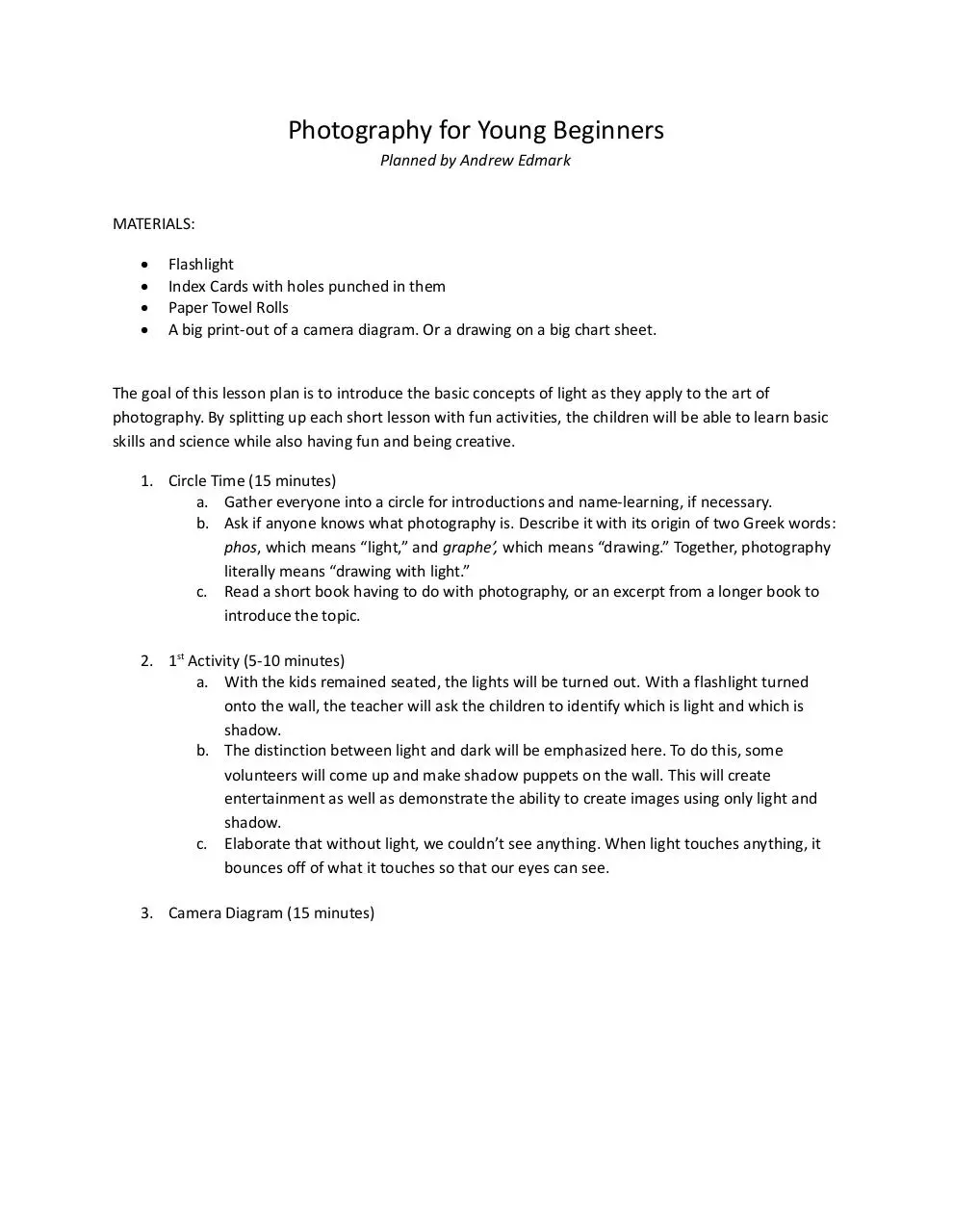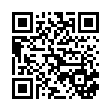Photography for Young Beginners (PDF)
File information
Author: University of Iowa
This PDF 1.4 document has been generated by Writer / LibreOffice 4.4, and has been sent on pdf-archive.com on 29/03/2015 at 08:35, from IP address 173.17.x.x.
The current document download page has been viewed 603 times.
File size: 60.16 KB (3 pages).
Privacy: public file



File preview
Photography for Young Beginners
Planned by Andrew Edmark
MATERIALS:
Flashlight
Index Cards with holes punched in them
Paper Towel Rolls
A big print-out of a camera diagram. Or a drawing on a big chart sheet.
The goal of this lesson plan is to introduce the basic concepts of light as they apply to the art of
photography. By splitting up each short lesson with fun activities, the children will be able to learn basic
skills and science while also having fun and being creative.
1. Circle Time (15 minutes)
a. Gather everyone into a circle for introductions and name-learning, if necessary.
b. Ask if anyone knows what photography is. Describe it with its origin of two Greek words:
phos, which means “light,” and graphe’, which means “drawing.” Together, photography
literally means “drawing with light.”
c. Read a short book having to do with photography, or an excerpt from a longer book to
introduce the topic.
2. 1st Activity (5-10 minutes)
a. With the kids remained seated, the lights will be turned out. With a flashlight turned
onto the wall, the teacher will ask the children to identify which is light and which is
shadow.
b. The distinction between light and dark will be emphasized here. To do this, some
volunteers will come up and make shadow puppets on the wall. This will create
entertainment as well as demonstrate the ability to create images using only light and
shadow.
c. Elaborate that without light, we couldn’t see anything. When light touches anything, it
bounces off of what it touches so that our eyes can see.
3. Camera Diagram (15 minutes)
a.
b. Present a diagram similar to the one above.
c. Explain that a lens is a piece of glass, like in a magnifying glass or a microscope, and that
the lens is responsible for taking in all of the light around us and records it.
d. Explain in very simple terms how the eye functions almost exactly like a camera.
i. The light travels through the eye, just like light travels through the lens of a
camera
ii. Then the light goes through a camera’s shutter, just as light will go through the
little optic nerve. If the children have trouble understanding what the optic
nerve is, explain to them that it’s like a power cord going to your brain so your
brain knows what you’re seeing.
iii. The light finally reaches the film (or memory card, since digital is much more
common now) where the image can be kept, just like what we see goes to our
brain where we can remember it.
4. Aperture and Shutter Activities (20 minutes)
a. The camera records light in two ways. Both need each other so that we can get a picture.
b. First there is the aperture. Basically, the aperture is like a pupil (the little black dot in
your eye). The bigger it is the more light you can see, just as the smaller it is, the less
light you can see.
i. To demonstrate, have each child partner up with someone and take turns
covering and uncovering their eyes while the other watches to see their pupils
get bigger and smaller.
ii. Explain that the pupils will get bigger and smaller just like the aperture will need
to be bigger or smaller so that there isn’t too much light and we are blinded, and
so that there isn’t too little light so we can’t see anything. (Overexposed vs.
underexposed)
c. Explain how eyelids are like a camera’s shutter, only opposite.
i. A camera’s shutter, unlike our eyelids, stays closed until a picture is taken. When
a picture is taken, the shutter opens very fast and then closes again. Depending
on how fast it opens and closes, the light will change. If a picture is very bright,
the shutter won’t be open for very long. If a picture is very dark, the shutter will
have to be open for a long time. With eyelids, it is the opposite. If it is very
bright we must shut our eyes so they don’t hurt, just as if it is very dark we try to
open our eyes as wide as we can so we can see.
ii. The children can take a moment to open and close their eyes and pretend they
are cameras.
d. Lastly, explain focus.
i. Shallow Focus
1. Shallow focus means that the camera will blur a lot of the picture,
leaving only one or a couple of things in focus.
2. To demonstrate this, the children can look through a paper-towel tube
and then place their hand in front of their eyes. Point out that
everything behind their hand is blurry and out of focus.
3. You get shallow focus when the aperture on a camera is big, just like the
paper towel roll.
ii. Deep Focus
1. Deep focus is the opposite of shallow focus, where everything in a
picture is sharp and in focus.
2. Demonstrate this by having the children look through a small punchhole in a card.
3. You get deep focus when the aperture on a camera is small, like the little
hole on the card.
5. Journal Entry and picture time
a. Finally, bring out a real camera and give a quick demonstration, explaining everything
learned with the action. Take a picture of the class, asking for one volunteer to come up
and give it a try.
b. Then, have the kids write in their journals with this prompt question:
i. If you were a photographer what would you take pictures of?
6. With the time remaining, let children use the camera to take pictures of others, and answer any
questions they might have.
Download Photography for Young Beginners
Photography for Young Beginners.pdf (PDF, 60.16 KB)
Download PDF
Share this file on social networks
Link to this page
Permanent link
Use the permanent link to the download page to share your document on Facebook, Twitter, LinkedIn, or directly with a contact by e-Mail, Messenger, Whatsapp, Line..
Short link
Use the short link to share your document on Twitter or by text message (SMS)
HTML Code
Copy the following HTML code to share your document on a Website or Blog
QR Code to this page

This file has been shared publicly by a user of PDF Archive.
Document ID: 0000217892.